Overview
The article examines the various types of ballots utilized in elections for union leaders, spotlighting essential methods such as:
- Paper ballots
- Electronic voting machines
- Mail-in ballots
Each ballot type is articulated with its respective advantages and implications for voter participation and election integrity. Furthermore, it emphasizes the necessity of adapting voting methods to enhance accessibility and trust within union elections. By understanding these ballot types, union leadership can make informed decisions that bolster voter engagement and uphold the integrity of the electoral process.
Introduction
Understanding the diverse types of ballots used in union elections is crucial for fostering democratic participation within labor organizations. Each ballot method, from traditional paper ballots to innovative electronic systems, plays a significant role in shaping voter engagement and trust. As unions strive to enhance electoral participation, important questions arise:
- Which ballot types best serve the needs of their members?
- How can technology bridge the gap between accessibility and security?
This exploration delves into the various ballot methods, revealing their unique advantages and challenges in the quest for a more inclusive electoral process.
Votem CastIron: Secure Online Voting for Diverse Elections
Votem’s CastIron platform revolutionizes the electoral process by providing secure and compliant online voting solutions tailored for unions and other organizations. With features such as encrypted ballots and an immutable audit trail, it ensures transparency and security—essential elements in maintaining public trust.
Furthermore, the platform’s mobile-first design empowers individuals to participate in elections from anywhere—whether at home, in the office, or while traveling—significantly increasing turnout. This capability is especially critical for union elections, where participation is paramount.
By harnessing advanced technology, Votem addresses the distinct requirements of labor organizations, ensuring that each vote is counted and safeguarded. This not only enhances participation but also fosters trust among members, ultimately strengthening the democratic process within unions.
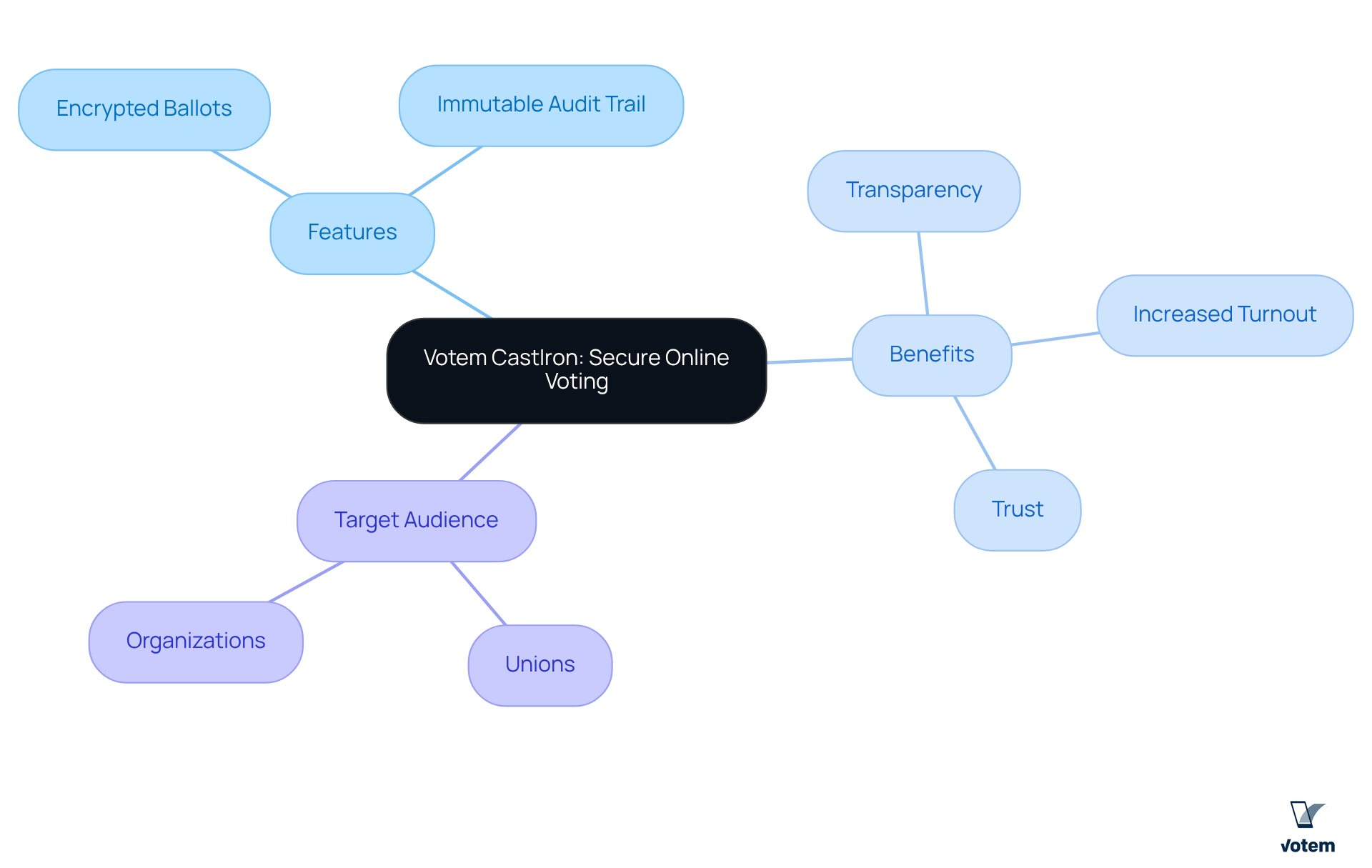
Paper Ballots: The Traditional Voting Method
Paper votes are considered one of the types of ballots used in elections, representing the most conventional voting technique that allows individuals to indicate their selections on a tangible sheet of paper. This method is frequently favored due to its simplicity and the physical aspect of the voting process, which can significantly enhance public confidence. In collective elections, the utilization of paper voting slips fosters a sense of assurance among participants, as they can physically manage and observe their selections, thereby strengthening the integrity of the electoral process.
While tallying paper votes can be time-consuming and prone to human error, many unions continue to prefer this method to ensure transparency and accountability. Current trends indicate a robust voter preference for paper options, which are one of the types of ballots used in elections, over electronic methods, as they provide a dependable means of verifying votes and upholding public trust in election results. Furthermore, the SAFE Act mandates the use of long-lasting, voter-verified paper slips in all election machines, further underscoring the significance of this approach in today’s electoral landscape.
Recent statistics reveal that in the 2020 elections, 93% of votes cast had a paper record, indicating the types of ballots used in elections and demonstrating a notable shift towards paper voting. This trend is especially crucial considering the vulnerabilities associated with electronic ballot systems, as highlighted during the 2018 Georgia gubernatorial and Texas senate races, where issues with paperless systems raised serious concerns about election integrity.
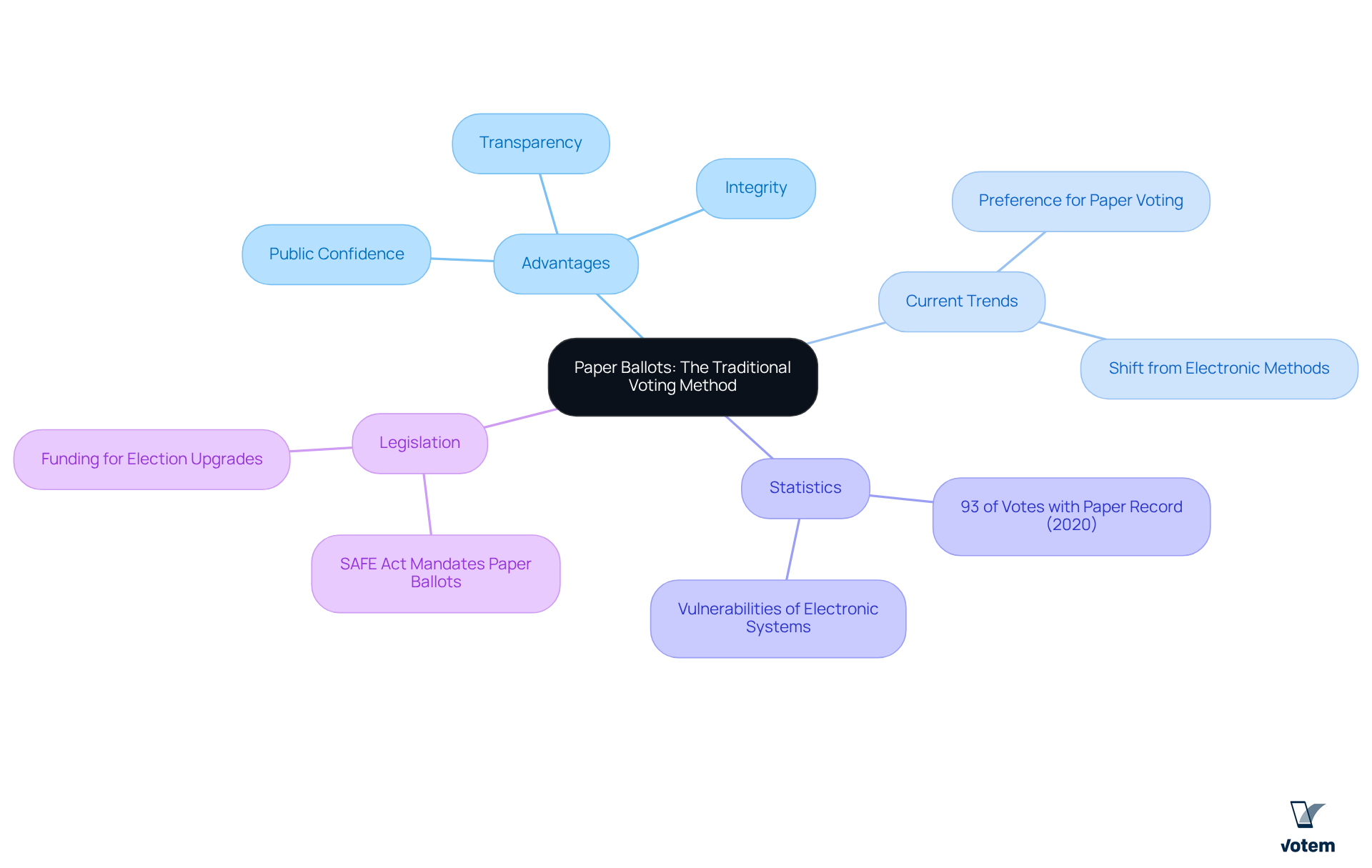
Electronic Voting Machines: Streamlining the Voting Process
Electronic ballot machines (EVMs) have revolutionized the electoral process, enabling individuals to submit their choices swiftly and effectively. With their intuitive interfaces, these machines provide immediate feedback, significantly enhancing the election experience. In collective elections, EVMs streamline the process, ensuring that results are counted rapidly and accurately—an essential factor in maintaining voter trust and engagement. For example, organizations that have embraced EVMs report increased participation rates, as evidenced by successful implementations within labor unions where electronic balloting has become standard.
However, despite these advantages, security concerns regarding EVMs persist as a critical issue. Unions must prioritize the selection of reputable vendors, such as Votem, which offer comprehensive election services, including:
- Logic and accuracy testing
- Custom design
- Help desk support
to mitigate potential vulnerabilities. The integrity of the election process is paramount; thus, adherence to stringent security protocols is non-negotiable. Recent discussions underscore the need for comprehensive guidelines to address these security challenges, ensuring that electronic ballot systems are robust against manipulation and fraud.
As the landscape of union elections evolves, the successful integration of EVMs hinges on balancing efficiency with rigorous security measures, fostering an environment where members feel assured in the electoral process. Quotes from experts, such as John Lund, Director of the Office of Labor-Management Standards, highlight the importance of addressing security concerns to ensure compliance and integrity in electronic voting. Furthermore, testimonials from satisfied clients reinforce Votem’s effectiveness in enhancing electoral participation and trust.
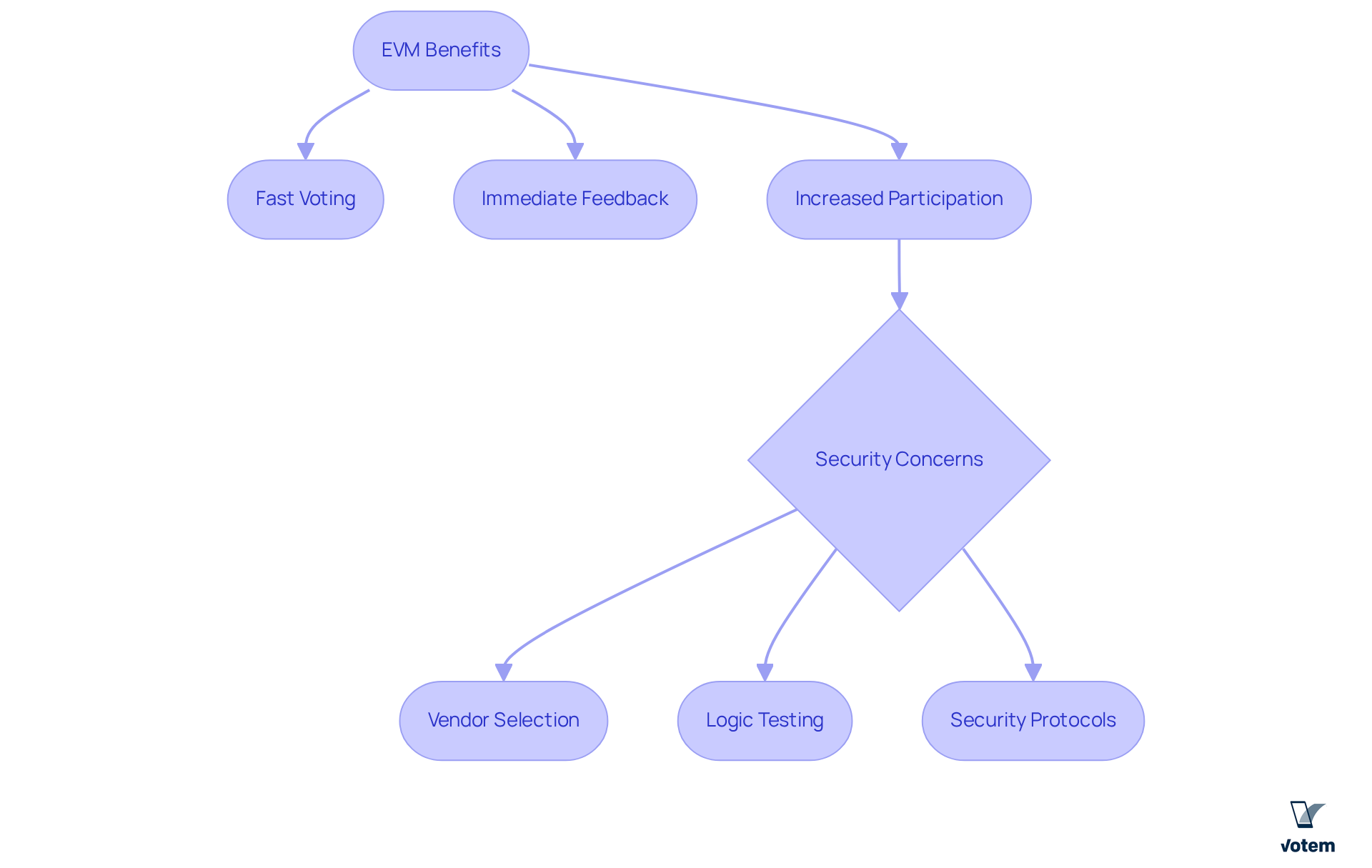
Mail-in Ballots: Enhancing Voter Accessibility
Mail-in ballots represent a convenient option for individuals who cannot physically attend polling places, making them particularly advantageous for union members with demanding work schedules or mobility challenges. This voting method has shown a significant enhancement in participation rates; for instance, states that adopted Universal Vote-by-Mail (UVM) experienced substantial increases in turnout, with Hawaii recording a 14% rise and Utah an 11% increase compared to previous elections. Furthermore, UVM elevated turnout among registered voters by 5.6 percentage points in the 2020 election, underscoring its effectiveness in boosting participation.
By allowing citizens to obtain and send their votes by mail, unions can enhance accessibility and engagement in the electoral process. Additionally, mail-in ballots can be developed with robust security protocols to ensure confidentiality, thereby fostering increased trust among participants. Successful initiatives within labor organizations, as evidenced in Hawaii and Utah, demonstrate that when members are provided the option to vote by mail, participation rates can rise significantly.
Notably, UVM has a particularly pronounced impact on turnout for young, Black, and Latino voters, emphasizing the importance of this method in modern elections. Votem’s innovative mobile ballot solutions have further improved accessibility, facilitating increased participation from diverse groups, including military personnel and individuals with disabilities.
While political tensions surround mail-in balloting, evidence indicates that it can function as a good-government reform that enhances accessibility and participation for citizens. As Linda McCullough pointed out, the implementation of Votem’s system allowed for greater access for all eligible individuals, showcasing the positive effects of mobile voting solutions amid the challenges posed by Covid-19.
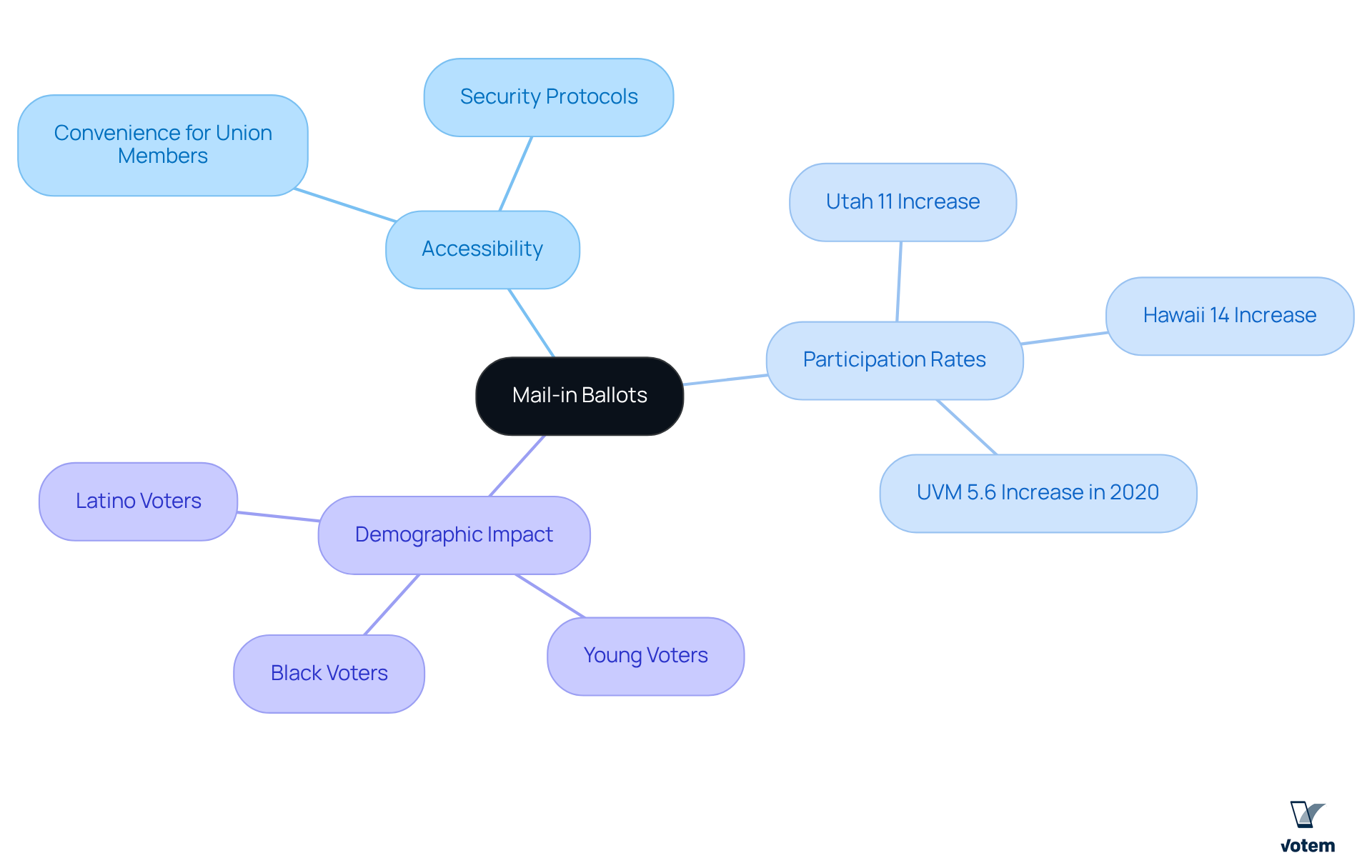
Provisional Ballots: Safeguarding Voter Rights
Temporary votes play a pivotal role when uncertainties arise regarding a participant’s eligibility. This method guarantees that individuals lacking the necessary identification or whose registration status is questionable can still cast a vote that will be counted once their eligibility is confirmed. Furthermore, for labor organizations, temporary votes are essential in safeguarding the rights of their members. They ensure that every qualified participant has the opportunity to engage in the electoral process, even amidst initial uncertainties. This approach not only protects individual rights but also reinforces the integrity of the electoral system, highlighting the critical need for union leadership to advocate for these measures.
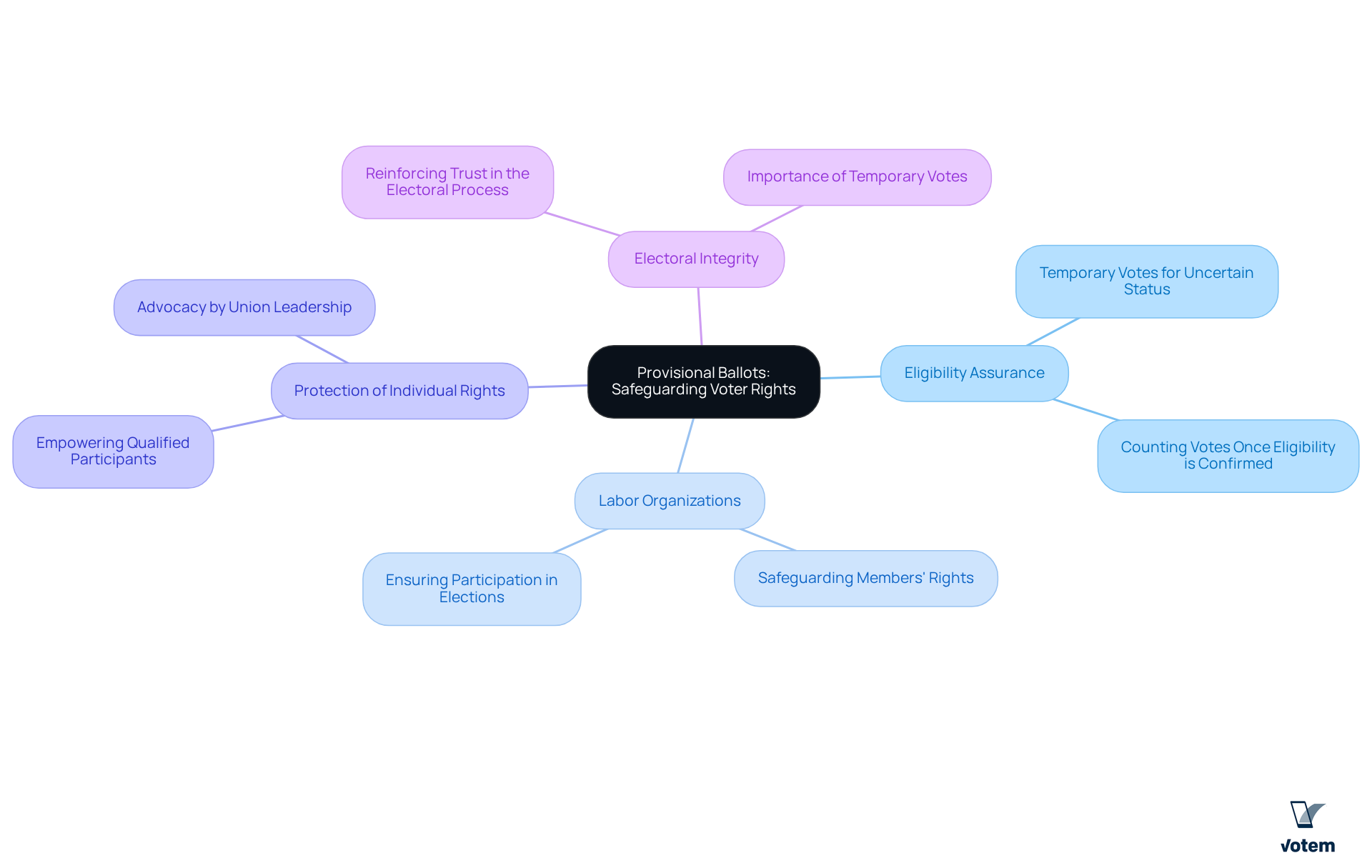
Ranked Choice Ballots: Promoting Voter Preferences
Ranked choice ballots are an example of the types of ballots used in elections that empower voters to rank candidates in order of preference, rather than limiting them to a single choice. This innovative method fosters more representative outcomes, ensuring that the winning candidate enjoys broader support.
In union elections, where multiple candidates may contend for leadership roles, the types of ballots used in elections, particularly ranked choice approaches, more accurately reflect the genuine preferences of the membership.
Furthermore, Votem’s versatile online voting platform enhances this process by facilitating accessible, secure, transparent, and auditable elections. This not only enables citizens to engage more effectively but also motivates candidates to connect with a wider audience, thereby promoting a more inclusive electoral atmosphere.
Such inclusivity is essential for enhancing electoral participation and building trust within the community.
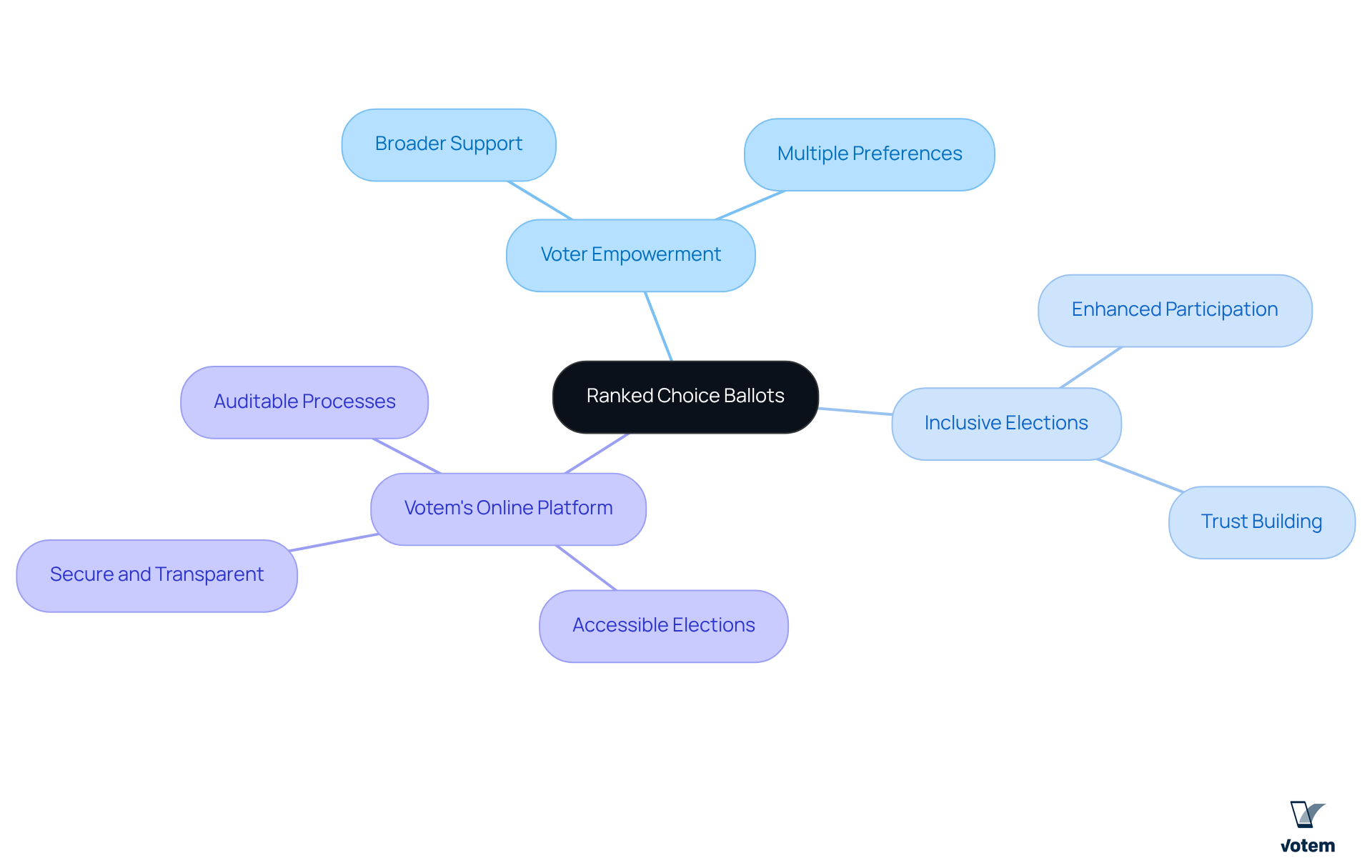
Absentee Ballots: Facilitating Participation for All Voters
Absentee voting empowers individuals to cast their votes remotely when they are unable to attend polling locations on election day. This is particularly crucial for union members who may find themselves working or traveling during the election period. By offering absentee ballots, unions can guarantee that all members have the opportunity to engage in the electoral process, regardless of their circumstances.
Furthermore, Votem’s innovative online voting solutions have significantly enhanced accessibility, fostering increased participation among all eligible individuals, including military personnel and those with disabilities. Customer testimonials underscore the effectiveness of Votem’s system, which has adeptly managed large volumes of votes, reinforcing the democratic principle that every voice matters.
This strategic approach not only elevates participation in elections but also ensures that they are conducted safely and effectively.
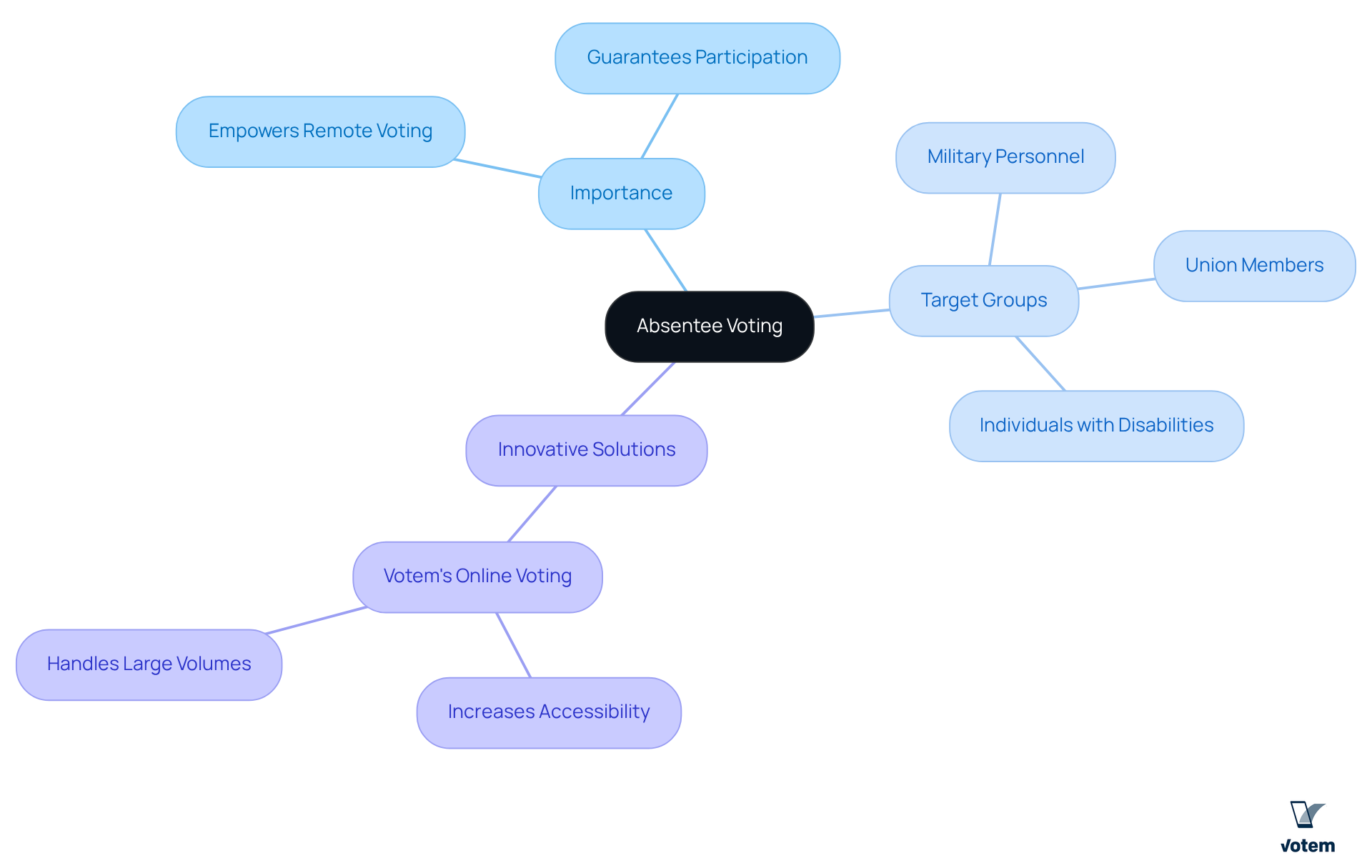
Ballot Initiatives: Direct Democracy in Action
Ballot initiatives serve as a powerful tool for direct democracy, enabling voters to propose and vote on specific legislation. This mechanism empowers collective members to advocate for essential changes that directly affect their rights and working conditions. By rallying around ballot initiatives, labor organizations can effectively mobilize their members to support measures aimed at promoting fair labor practices, enhancing benefits, and strengthening workplace protections.
For instance, initiatives such as the Election Rigging Response Act illustrate how organized groups can unite to counteract political maneuvers that jeopardize labor rights, ensuring that their voices resonate within the legislative process. In Colorado, where the membership rate was only 8 percent in 2024, the significance of such initiatives becomes even more pronounced as organizations strive to amplify their influence.
Successful voting initiatives can lead to substantial reforms in labor laws, showcasing the profound impact of collective action in shaping a more equitable workplace environment. As unions continue to leverage these initiatives, they not only advocate for their members but also reinforce the critical importance of participation in the democratic process.
As Dennis Dougherty noted, the mobilization around these initiatives is vital for safeguarding labor rights against potential threats like right-to-work laws.
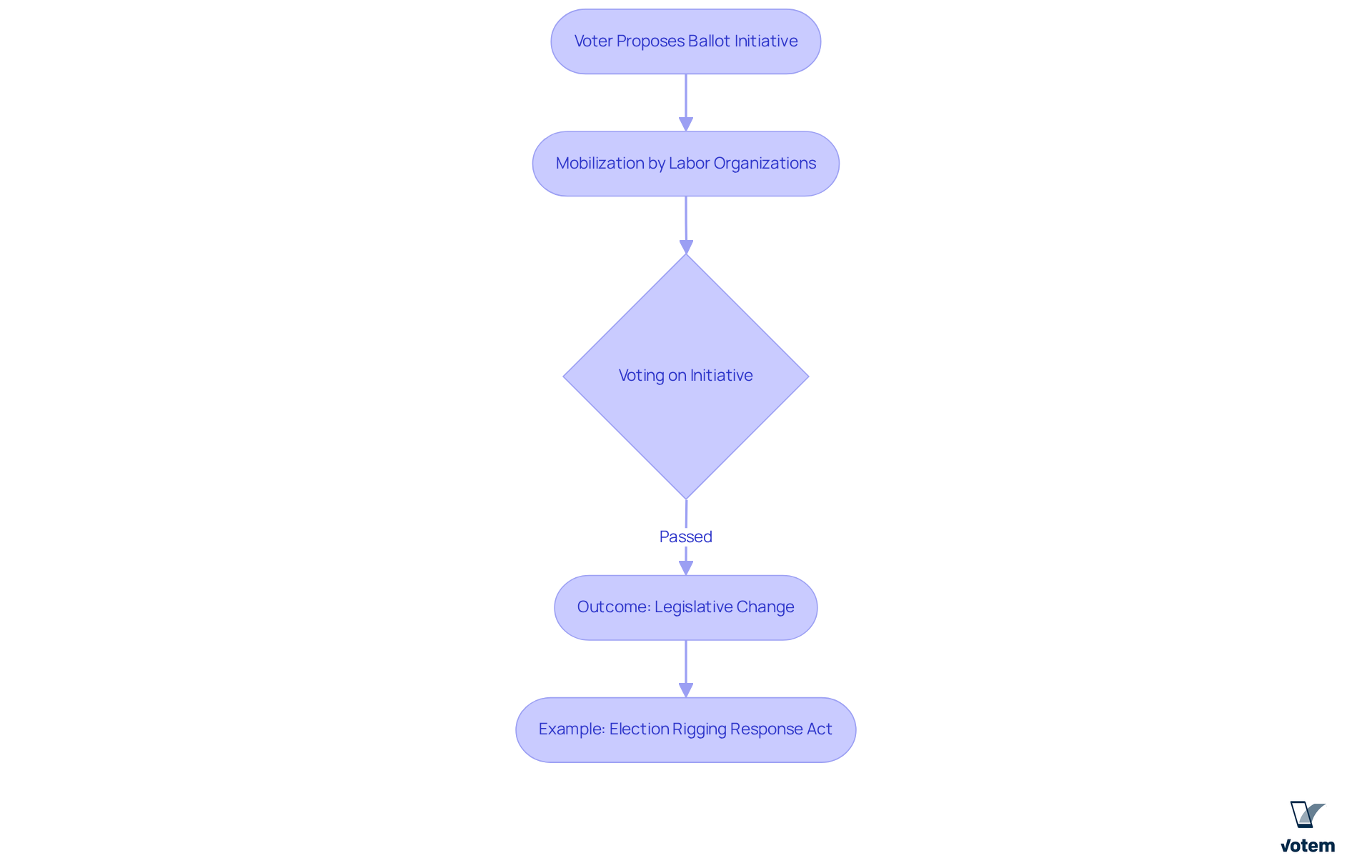
Blank Ballots: A Statement of Voter Discontent
Blank votes represent a decisive choice by individuals who opt not to select any candidates on the voting sheet. This action serves as a powerful statement of discontent, signaling that voters are dissatisfied with the options available to them.
For leaders of organizations, understanding the reasons behind these unmarked votes can provide significant insights into member sentiments and areas for improvement. By addressing the concerns that lead to empty votes, unions can enhance their engagement with members and ensure that future elections align more closely with their preferences.
Furthermore, recognizing the underlying issues can foster a more inclusive environment, prompting members to feel valued and heard in the electoral process.
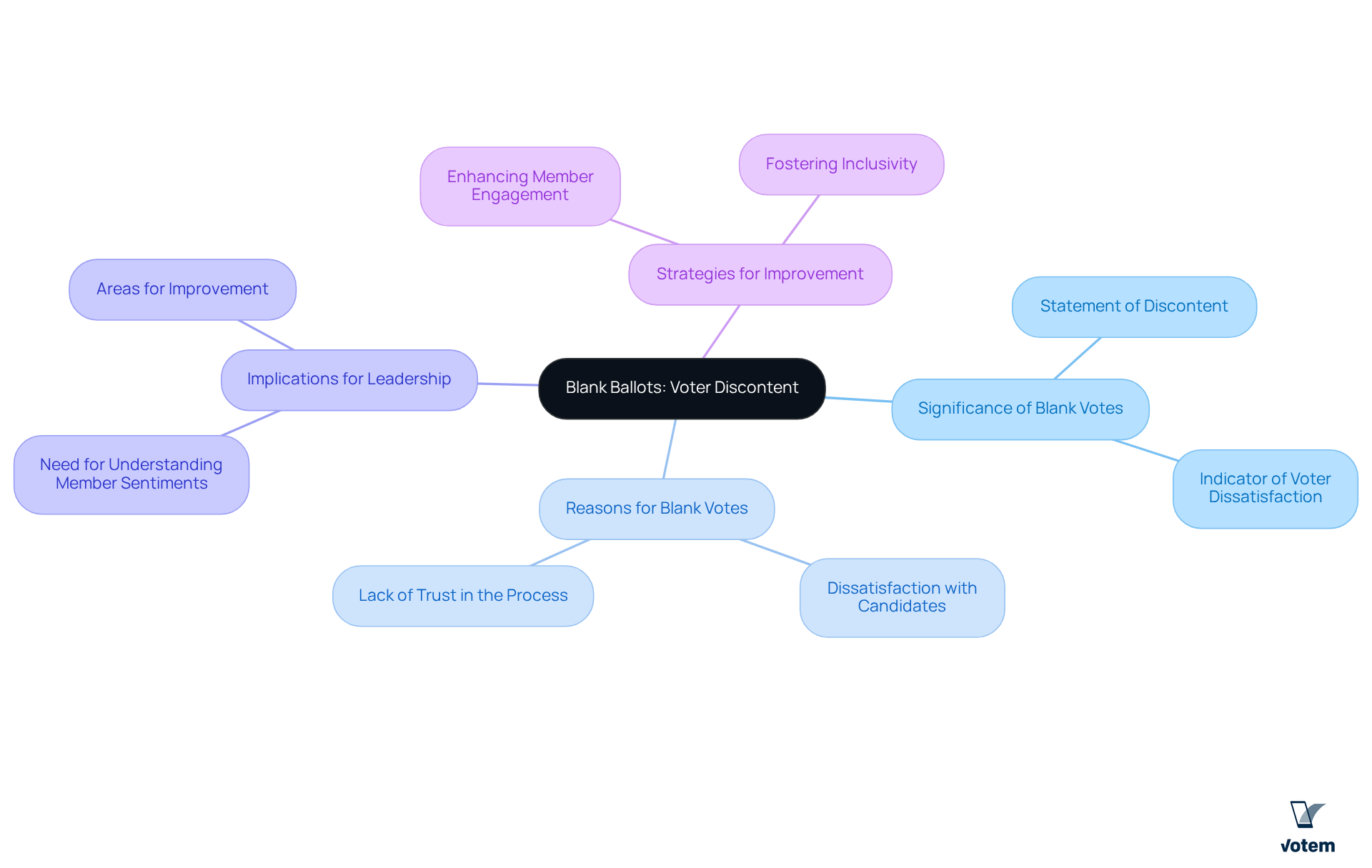
Special Ballots: Addressing Unique Voting Needs
Special ballots are specifically designed to meet the unique needs of various groups of electors, including individuals with disabilities and military personnel. Votem’s innovative online voting solutions significantly enhance accessibility, ensuring that all qualified individuals can participate in elections, irrespective of their circumstances. As Linda McCulloch aptly noted, ‘Implementing Votem’s new, modern system which allowed greater access for all qualified voters from military voters to voters with disabilities was my greatest accomplishment in office.’ This statement underscores the importance of such systems in creating a more inclusive electoral environment.
For unions, the provision of special ballots is essential in fostering an inclusive electoral atmosphere that respects the diverse needs of their membership. By accommodating various voting requirements, Votem not only enhances participation but also guarantees that every voice is heard in the electoral process. This is exemplified by Votem’s successful handling of the receipt of 299,000 votes on behalf of the National Radio Hall of Fame, marking a significant increase from the previous year’s 126,000 votes received.
In conclusion, the implementation of Votem’s solutions not only addresses the immediate needs of electors but also sets a precedent for future electoral processes. Union leadership must recognize the value of these innovations in promoting inclusivity and ensuring that all members can exercise their right to vote effectively.
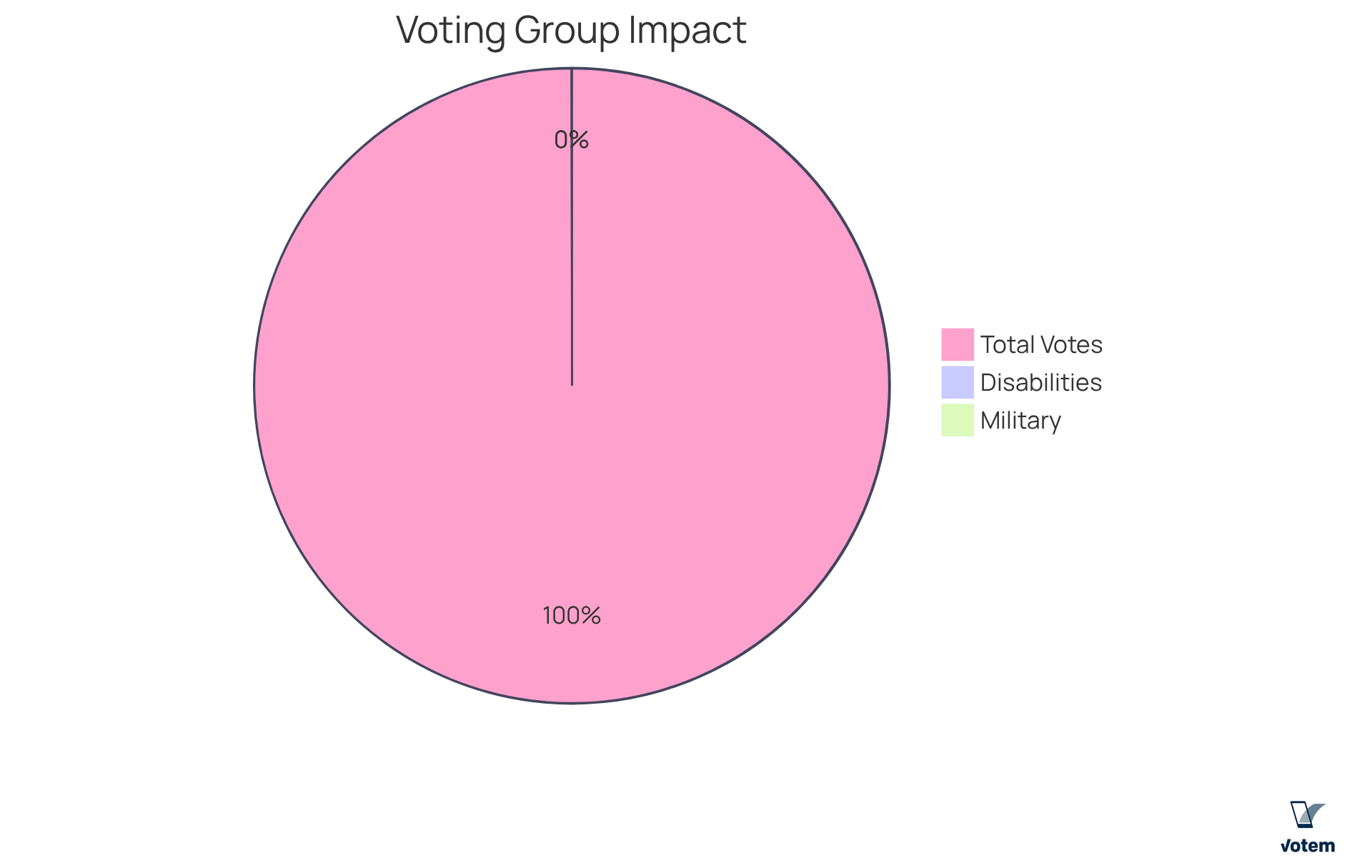
Conclusion
The diverse landscape of ballots used in elections for union leaders exemplifies the myriad ways organizations can engage their members and uphold democratic principles. From traditional paper ballots to innovative digital solutions like Votem’s CastIron platform, each method presents unique advantages tailored to different voter needs and preferences. Understanding these various ballot types is essential for fostering participation and ensuring that every voice is heard in the electoral process.
Throughout this discussion, key insights into the functionality and benefits of each voting method have been explored. Paper ballots continue to provide a reliable and transparent option, while electronic voting machines enhance efficiency and accessibility. Mail-in and absentee ballots have proven invaluable in increasing voter turnout, particularly for those facing mobility challenges. Provisional and special ballots ensure that no eligible voter is left behind, safeguarding the rights of all members. Furthermore, ranked choice and ballot initiatives empower voters to express their preferences more fully, fostering a more representative electoral outcome.
As the electoral landscape evolves, embracing these various ballot methods is crucial for unions striving to enhance participation and trust among their members. By leveraging technology and understanding the unique needs of their electorate, union leaders can create a more inclusive and effective voting environment. Engaging with these innovative solutions not only strengthens the democratic process but also reinforces the commitment to representing the voices of all members within the organization.
Frequently Asked Questions
What is Votem’s CastIron platform?
Votem’s CastIron platform is a secure online voting solution designed for unions and organizations, featuring encrypted ballots and an immutable audit trail to ensure transparency and security in the electoral process.
How does the CastIron platform enhance voter participation?
The mobile-first design of the CastIron platform allows individuals to participate in elections from anywhere, significantly increasing turnout, which is particularly important for union elections.
What are the advantages of using paper ballots in elections?
Paper ballots are favored for their simplicity and the physical aspect of voting, which enhances public confidence. They allow participants to manage and observe their selections, thus strengthening the integrity of the electoral process.
Why do many unions continue to prefer paper voting?
Unions prefer paper voting because it ensures transparency and accountability, despite being time-consuming and prone to human error. Additionally, the SAFE Act mandates the use of long-lasting, voter-verified paper slips in election machines.
What percentage of votes in the 2020 elections had a paper record?
In the 2020 elections, 93% of votes cast had a paper record, highlighting a significant preference for paper voting among voters.
What are electronic voting machines (EVMs)?
Electronic voting machines (EVMs) are devices that enable individuals to submit their votes quickly and effectively, providing immediate feedback and streamlining the voting process.
What are the benefits of using EVMs in collective elections?
EVMs enhance the election experience by ensuring results are counted rapidly and accurately, which helps maintain voter trust and engagement, leading to increased participation rates.
What security concerns are associated with EVMs?
Security concerns regarding EVMs include potential vulnerabilities to manipulation and fraud. It is crucial for unions to select reputable vendors and adhere to stringent security protocols to mitigate these risks.
What services does Votem provide to ensure election integrity?
Votem offers services such as logic and accuracy testing, custom design, and help desk support to ensure the integrity and security of the election process.
Why is it important to address security concerns in electronic voting?
Addressing security concerns is essential to ensure compliance and integrity in electronic voting, fostering an environment where members feel assured about the electoral process.
List of Sources
- Paper Ballots: The Traditional Voting Method
- Paper Ballots Helped Secure the 2020 Election — What Will 2022 Look Like? (https://brennancenter.org/our-work/analysis-opinion/paper-ballots-helped-secure-2020-election-what-will-2022-look)
- Why paper is considered state-of-the-art voting technology | Brookings (https://brookings.edu/articles/why-paper-is-considered-state-of-the-art-voting-technology)
- State Senator Liz Krueger (https://lizkrueger.com/the-importance-of-paper-ballots-recounts-in-elections)
- Paper ballots are good, but accurately hand-counting them all is next to impossible (https://theconversation.com/paper-ballots-are-good-but-accurately-hand-counting-them-all-is-next-to-impossible-211989)
- Electronic Voting Machines: Streamlining the Voting Process
- Guidelines for the Use of Electronic Voting Systems in Union Officer Elections (https://federalregister.gov/documents/2011/01/11/2011-311/guidelines-for-the-use-of-electronic-voting-systems-in-union-officer-elections)
- Electronic voting: How to effectively succeed in your elections? (https://imagina.com/en/blog/article/modernizing-elections-the-electronic-vote)
- Electronic Voting System for Associations, HOAs, Unions, and Other Delegate Bodies (https://meridiaars.com/electronic-voting-system-for-hoa-and-business-associations)
- Mail-in Ballots: Enhancing Voter Accessibility
- U.S. Postal Service Releases 2024 Post-Election Analysis Report Detailing the Successful Efforts Taken to Deliver the Nation’s Election Mail Securely and Effectively (https://about.usps.com/newsroom/national-releases/2024/1202-usps-releases-2024-post-election-analysis-report.htm)
- States that send a mail ballot to every voter really do increase turnout, scholars find • Washington State Standard (https://washingtonstatestandard.com/2023/10/09/states-that-send-a-mail-ballot-to-every-voter-really-do-increase-turnout-scholars-find)
- Ballot Initiatives: Direct Democracy in Action
- Advocates Withdraw Dueling Labor Union Initiatives – But Ballot Battle Still Looms (https://westword.com/news/colorado-labor-ballot-initiatives-withdrawn-battle-looms-25173666)
- Vote YES on Prop. 50! Unions Leading the Fight to Defend Democracy (https://cta.org/educator/posts/unions-leading-the-fight-to-defend-democracy)
- Ballot Initiatives Threaten Health Care at a Precarious Time – California Hospital Association (https://calhospital.org/ballot-initiatives-threaten-health-care-at-a-precarious-time)
- UDW, One of CA’s Largest Unions Representing over 220,000 Providers, Launches Massive Mobilization Campaign to Pass Prop 50 – UDW – Fighting for Workers and Our Communities (https://udw.org/press-releases/udw-one-of-cas-largest-unions-representing-over-220000-providers-launches-massive-mobilization-campaign-to-pass-prop-50)

